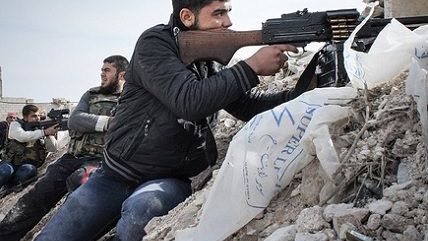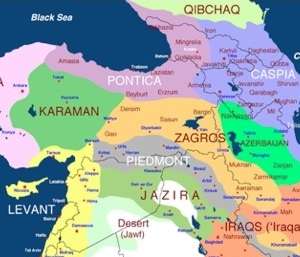U.S. Military Intervention in Syria Is a Really Bad Idea
And would show American policymakers have learned nothing in the last decade


In a column for USA Today, senior Brookings Institution fellow Michael O'Hanlon argues for a US-led Bosnia-style military intervention in Syria, pinning his call to the "surreal" but "appropriate" debate over whether the Syrian regime has used chemical weapons. O'Hanlon writes that the U.S. intelligence-verified use of Syrian chemical weapons would necessitate, at the minimum, U.S. missile strikes against the perpetrating units, citing Barack Obama's "red line." That red line, it ought to be noted, was shifted to the "systematic use" use of chemical weapons. The president also said just a few days ago that the international community would have to be "confident" of that use. Despite other interventionist machinations, then, Obama does not seem intent on lobbing cruise missiles into Syria just yet. The president is wise to be cautious and ought to be much more so, especially considering the government's renewed internal debate over whether to arm Western-backed factions in the Syrian rebellion.
In his column, O'Hannon acknowledges the "do something" strain of politics in the pro-interventionist urges for Syria, but seems to believe having an idea for an "exit strategy" is enough "to get beyond the impulse just to 'do something.'" Of course, it ought to go without saying that George Bush and Iraq war supporters thought they had an exit strategy too. O'Hannon's proposed exit strategy is of the same vein as Joe Biden's 2006 proposal for a kind of soft partition of Iraq. Like Biden, O'Hannon looks to the Balkans for a solution to Syria, and specifically Bosnia as the "best first draft." He compares the atrocities in Syria to those in Bosnia and Herzegovina during the collapse of Yugoslavia where a US-led intervention hit Serbian militias in the war zone to force a peace treaty (the Dayton Accords). O'Hannon acknowledges the situation in Syria is complex (because the insurgency is more "fractured") but believes that American support for the rebels now and during an eventual Syrian reconstruction, as well as "pledges of international participation" would be enough to surmount that and wage a successful U.S.-led military intervention to finally topple the Assad regime. O'Hannon envisions an ethno-centered split of Syria to provide Assad's Alawaites (sans Assad, naturally) territory along the coast and the Kurds territory in the north.

But the situation in Bosnia then is completely different from the situation in Syria today. The two are both former territories of the Ottoman Empire and, indeed, seem to be wracked by the same underlying ethnic tensions that have been suppressed by decades of strongman rule (in Yugoslavia Tito, in Syria the Assad family; also seen in Iraq post-Saddam). Yet the situation in Bosnia was confined to the former Yugoslavia. The ethnic lines of division crisscrossed that post-World War I construct but didn't reach far beyond it. Not so in Syria, where the ethnic lines of division crisscross the entire Middle East. The ruling Alawites fall under the umbrella of Shia Islam, explaining in part Iran's support of the regime, while the country itself is majority Sunni, like most of the wider Muslim Middle East (other notable exceptions are Iran, next door Iraq and the tiny island kingdom of Bahrain).
Further, in Bosnia, the U.S. took the lead as part of the role it adopted for itself during and after the Cold War as Western Europe's military brains and muscle. The European Union did not exist in the early 1990s, but the project of European integration was already decades old. And politically, Europe was united in regards to the situation in Yugoslavia. Seeking to build a precedent in post-Cold War Europe, the United States took a military lead welcomed by Europe. Not so in the Middle East, which is neither as economically/politically unified as Europe was even in the early 90s, and where there is no consensus on the idea of the U.S. as the military muscle in the region. It is challenged both in the capitals of the Middle East and in Washington. Even the perception of consensus on a U.S.-led intervention in Syria is a mirage. We need look no further back than the 2011 intervention in Libya (which was a U.S.-led intervention spurred by Europe; how little things change). The president and European leaders touted the support of the Arab League. Yet when the intervention started, it faced criticism from the Arab League for its intensity, walking back previous enthusiasm. Yet the Middle East today is not the military lightweight Europe was (and largely is). The United States does billions of dollars' worth of arms business with Middle Eastern countries (and not just Israel at all).
The Arab League, once again, as in Libya, is calling for regime change, and so they ought to take the lead on it. O'Hannon admits his suggested approach won't be easy and "will hardly guarantee a great outcome," but writes that it's "far more promising than the trajectory we are on." In Hannon's mind, that trajectory is an escalating humanitarian crisis and non-action by the United States. In reality, the trajectory appears to be increased Western involvement, despite a lack of international support even for arming Syrian rebels. The solution to Syria ought to come from local and regional stakeholders, like Turkey, which is seeking to build influence in the region and on the global stage, Jordan, Saudi Arabia and/or even Iran or Israel. The American instinct to jump to the head of the line on intervention means it will remain the go-to sucker for "humanitarian crises," something it can't afford any more of in blood or treasure.


Show Comments (82)